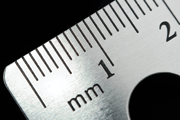E-Archive
Good Vibrations
in Vol. 10 - July Issue - Year 2009
Good Vibrations – a Double Impact?

The surface makes the difference in

It is the surface, which makes simple products shine bright
Good vibrations, what does that mean? Why are they useful? Are they useful at all? Well, possibly some of us connect “good vibes” to a positive feeling, to a real nice chill out party atmosphere, to summer, sun and sunshine.
The mere mechanical vibrations of common mass finishing procedures also produce also emotional or perceptional good vibrations. The name of this column therefore hits the point exceptionally well in a double sense. You may yourself ask now how vibratory forces can have something to do with good feelings, but the answer is quite simple.
Vibration is necessary as a mechanical force to achieve mechanical results on surfaces of different materials. This concept is used for example in the world-wide spread installations of vibratory finishers of different forms. On the one hand the finishing via vibration is used to influence the physical properties of surfaces, because there is a technical need to do so. Perhaps the surface roughness of a part has to be smoothened in order to install it into another assembly. Perhaps the edges should be broken to reduce the sharpness of the part, because people could be hurt by a very sharp edge when they touch it. The technical reasons for vibratory finishing are manifold.
So in the past vibratory finishing was often brought about technical necessities. This mere focus on technical necessities has changed a little bit in the last years. Today companies want their products to appear nice and clean, sometimes also bright. Even when there is no technical argument for parts to have a nice shiny surface, the wish to deliver nice and optically perfect parts is becoming more and more obvious – and for good reason.
In the press for new product developments you find more and more often a term like “haptic perception”. Wikipedia, which of course should not be considered as a trustful source of information in scientific terms, but which often gives interesting data about new terms, defines “Haptics” as follows:
“Haptics refers to the sense of touch (from Greek apt? = “I fasten onto X, I touch X” (where X is the object of the verb)). It may refer to:
• Haptic technology, technology that interfaces with the user through the sense of touch
• Haptic communication, the means by which people and other animals communicate via touching
• Haptic perception, the process of recognizing objects through touch”
Visual perception, design, touching of products, smelling and feeling are becoming more important for products even in the industrial sector of business to business deals. In the world of surface finishing products, the touch of products is important in two aspects: On the one hand a smooth and fine touch itself gives a feeling of high quality, of high value, independent of the technical effect. On the other hand the “fine touch” gives real and fundamental technical advantages, which were vital for the piece quality itself.
So haptic and appearance have obviously become a firm component of modern product development processes in all branches, where companies are trying to determine customer wishes and to reflect these wishes within their product properties. Often this process is started in the early stages of product development, because many enterprises have understand that you can not check quality effectively in a product after it has already been manufactured, but that you have to plan quality at the very start of the product development process.
The reasons for that development are manifold, but simple. The often-cited change from seller to buyer-markets and the connected pressure to stand out against many competitors are only one point why people appreciate a good optical appearance even in a robust industrial surrounding. In nearly every field of the business world people have discovered the power of “look and feel”, a term so far mostly used for software user interfaces. Today products must differ from the one which competitors are able to offer. Differentiation is the only way to escape a rigorous and attritional price battle.
To differentiate products means also to provide them with a surface of high quality appearance. But that request has to be payable, because it must not have a too strong effect on the price of the product.
And exactly here the “good vibrations techniques” of surface finishing create “good vibration feelings”, because vibratory finishing techniques are making products look and feel better and are always cost-effective processes of mass finishing, which have nearly no relevant impact on production costs per piece. So now it becomes crystal clear why “good vibes” lead inescapably to good business in a double sense.
Good Vibrations
by Mathieu Geuting
Spaleck Oberflächentechnik GmbH & Co. KG
Tel. +49.2871.9500.14
Fax +49.2871.9500.95
E-mail: m.geuting@spaleck.biz



























